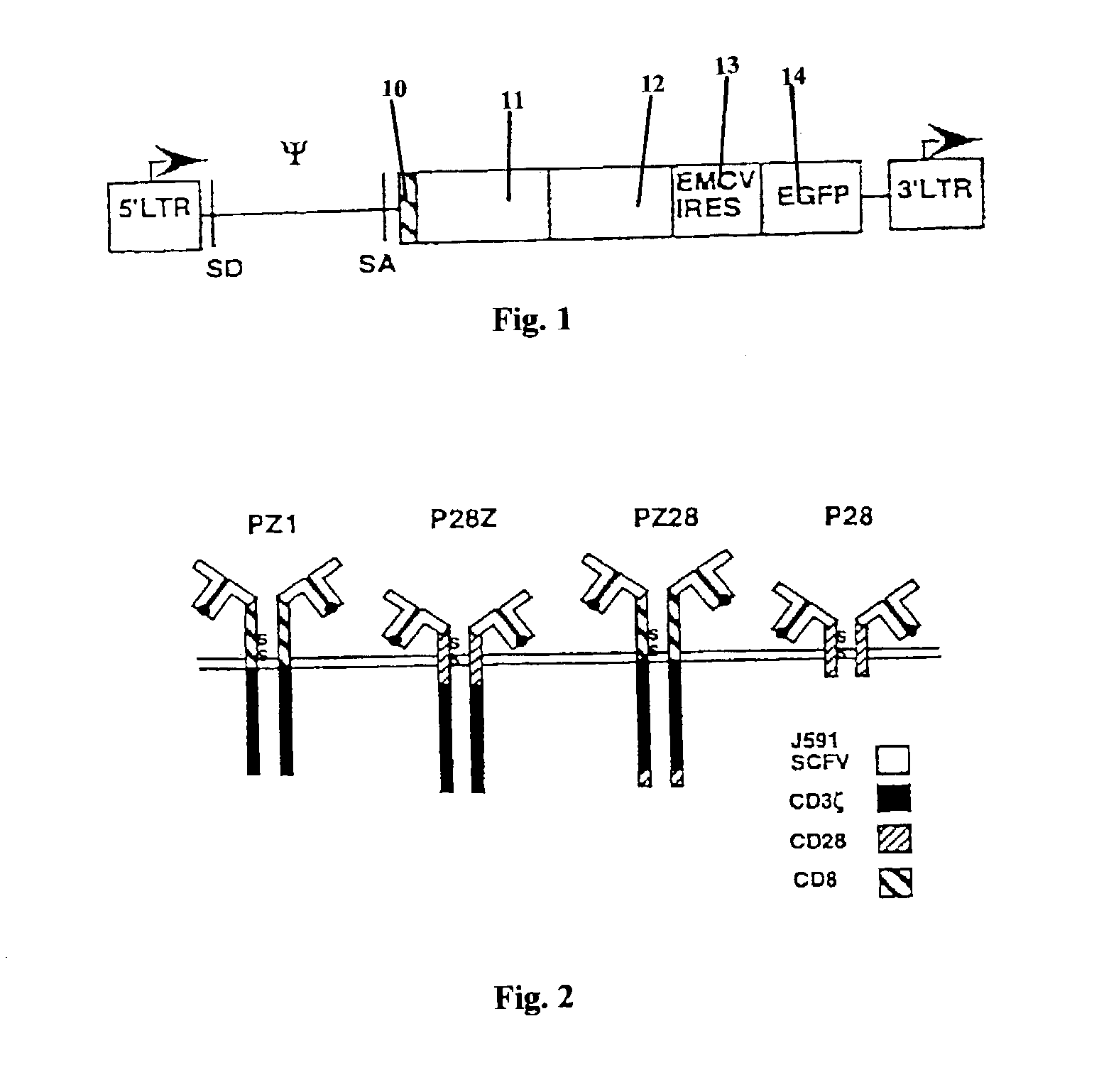Chimeric T cell receotors
a t cell receptor and nucleic acid polymer technology, applied in the field of chimeric t cell receptors, can solve the problems that the engagement of .zeta.-chain fusion receptors may not suffice to elicit substantial il-2 secretion in absence, and the induction of potent tumor immunity is a major challenge in cancer immunotherapy, so as to maintain the ability to mediate specific lysis, reduce the dose of t cells, and the effect of shor
- Summary
- Abstract
- Description
- Claims
- Application Information
AI Technical Summary
Benefits of technology
Problems solved by technology
Method used
Image
Examples
example 2
[0039] Culture and retroviral transduction of primary human T cells. Peripheral blood mononuclear cells from healthy donors were established in RPMI+10% (vol / vol) human serum, activated with phytohemagglutinin (2 .phi.g / ml) for two days, and transferred to non-tissue culture-treated plates (Falcon, Becton Dickinson, Franklin Lakes, N.J.) precoated with retronectin (15 .phi.g / ml; Takara Biomedicals, Shiga, Japan). Gibbon ape leukemia virus envelope-pseudotyped retroviral particles were generated as described.sup.27,40. Transduced cells were co-cultivated with NIH3T3 fibroblasts expressing PSMA and / or B7.1 as described.sup.18,23. For experiments with LNCaP cells, cells were admixed weekly at a T-cell: tumor cell ration of 5:1.
[0040] For protein analyses, flow cytometry was carried out using a FACScan cytometer with Cellquest software. Expression of PSMA-specific fusion receptors was directly demonstrated using phycoerythrin (PE)-conjugated goat anti-mouse antiserum-.sup.18. CD4-PE and...
example 3
[0044] Cytotoxicity assays. Cytotoxic T-lymphocyte assays were performed using a nonradioactive cytotoxicity detection kit (lactate dehydrogenase (LDH); Roche Diagnostics, Indianapolis, Ind.) as described.sup.18.
[0045] To confirm that the TCR.zeta.-CD28 fusion receptors specifically engaged PSMA, cytotoxicity assays were performed three days after the transduction. T-cells were transduced with 19z1 GFP (control), Pz1 GFP, or Pz28 GFP. Three days after completion of gene transfer, 4 h CTL assays were established at the indicated ratios using as targets NIH3T3 cells expressing PSMA. No specific lysis was observed using untransduced NIH3T3 as control targets. The greater lytic activity of Pz1-transduced cells may reflect the higher cell-surface expression of this receptor, or, more likely, the greater proportion of transduced T-cells (46% of T-cells, of which 21% are CD8+, compared with 25% P28z-transduced cells, including 12% CD8+, and 20% Pz28-transduced cells, including 10% CD8+ cel...
example 4
[0047] P28z-transduced T-cells were stimulated on NIH3T3 cells expressing PSMA and, after one week, were established in 4 h CTL assays with NIH3T3 cells expressing PSMA or untransduced cells as controls. At this time, the T-cells were 62% GFP+ (of which 17% were CD8+). (FIG. 3B)The fusion receptor P28z elicits IL-2 production upon engagement with PSMA. To assay the ability of the different receptors to signal for IL-2 production, transduced PBLs were co-cultivated with NIH3T3 cells expression PSMA and / or B7.1 (refs 18,19) in medium lacking IL-2 (Table 1). Three receptors (Pz1, P28z, and Pz28) elicited IL-2 secretion in the presence of the PSMA and B7.1. In the absence of the co-stimulatory ligand, IL-2 production was only observed in cultures of P28z-transduced T-cells. IL-2 levels were elated, ranging within 40-55% of those obtained by co-culturing the same transduced T-cells with the monolayer co-expressing PSMA and B7.1.
[0048] The P28z fusion receptor promotes proliferation of ge...
PUM
| Property | Measurement | Unit |
|---|---|---|
| nucleic acid | aaaaa | aaaaa |
| fluorescent | aaaaa | aaaaa |
| cell-surface expression | aaaaa | aaaaa |
Abstract
Description
Claims
Application Information
 Login to View More
Login to View More - R&D
- Intellectual Property
- Life Sciences
- Materials
- Tech Scout
- Unparalleled Data Quality
- Higher Quality Content
- 60% Fewer Hallucinations
Browse by: Latest US Patents, China's latest patents, Technical Efficacy Thesaurus, Application Domain, Technology Topic, Popular Technical Reports.
© 2025 PatSnap. All rights reserved.Legal|Privacy policy|Modern Slavery Act Transparency Statement|Sitemap|About US| Contact US: help@patsnap.com



